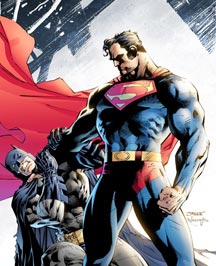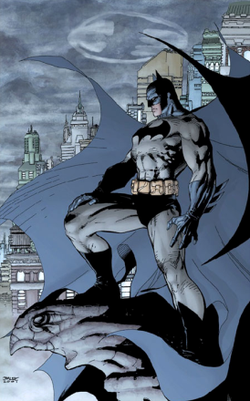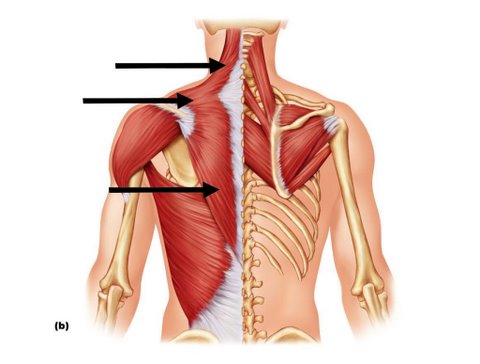V for…. very nice physique?
Take a look at the letter V. Then take a look at the guy to my right – on the right… and sorry Batman…
The thick traps (semi-covered by the cape) that slope down into the extremely broad shoulders. The shoulders that are pulled back and sit on muscular lats which then taper down to the waist. Each of the above components make this waist appear much smaller.
This is the V. This is the ideal physique for men (an X shape if you count the lower body), and this is what I’m going to help you achieve in this article, and the following series.
Let’s break this V Shape down into 3 key muscle groups.

1. The Lats (back muscles) – Help our shoulders look broader by pulling them back. They make the waist look thinner, and taper our shoulders down to our waste, actually creating the “V”. As I mentioned in describing Superman, our shoulders also ‘sit’ on our lats… if they’re big enough, of course.
3. The Traps – Give the shoulders breadth. They give us more of an athletic look/appearance, and contribute to the upper “V” look along with the shoulders.2. The Shoulders – Create the upper part of the “V”. They give the lats and traps something to work with and make our waist appear thinner.
More than any others, these 3 muscles give us the V Shape Torso that we want, but not a lot of us are training these muscles to look the way we’d like them to look. We develop more compact shoulders, lats, and traps. When width is what we’d actually like to create. Or, we only focus on wider grips, but fail to build the thickness in the muscle that is required for this ideal look. OR, we bulk and build ROUND muscle, but not the ripped muscle like ze Batman’s and Superman’s have.
The V Shaped Torso
How do we build this torso, shape and physique? And why the shite do more of us resemble an “O” or an “H” than a “V”?
Well, there are a lot of components. Building the right muscles the right way and in the proper proportions, getting consistent gains, having high levels of the right hormones and low levels of the wrong ones… and the list goes on. Today we’re going to look at building the right muscles with the best exercises possible.
In this article I’m going to break down the 3 most important muscle groups to train, starting with the lats, the deltoids, then traps. I’ll give you a few exercises for each muscle group, then I’ll take you through a few of my favourites in a video at the end.
Note: read “How to Become a Skinny Fat Man“, and “50 Facts About Mens Fitness” along with this article. Both will prove very helpful.
1. Building Wide Lats
Common Mistake: only concentrating on wide-grip exercises.
Yes, we need to focus on building width in our lats to get a V Shape. But we also need to build thickness in the lower lat, where our muscle meets our torso, if we’re going to develop the V Shape we want and build the right thickness in the muscle.
So, while wide grips are very important, close grips are as well. PLUS, building our lats isn’t simply about chin-ups or pulldowns – although both are great exercises – it has a lot to do with rowing as well. The bent over row, Yates row, and inverted row are some of the best exercises for building wide lats and a broad upper back.
Should we pull more or push more?
Pull more. Building broader lats pulls our chest and shoulders back, but also gives our shoulders something to ‘sit on’, giving them width that deltoid training alone can’t accomplish. Both trap and lat training require pulling. Most routines you see in the gym these days focus on the mirror muscle, but have adverse effects (hunched/slouched shoulders, and con caved chesticles).
4 super awesome back exercises:
Mid Lat/Traps: Inverted Row
Outer/Upper Lat: Wide-grip chin-up/pulldown
Lat Thickness: Yates Row
Lower Lat: Close grip chin-up/pulldown
2. Developing Broad Shoulders
Common Mistake: only focusing on the anterior (front) deltoid.
Our deltoids are made up of 3 heads, the posterior, lateral, and anterior deltoid muscles make up our shoulders. To build broad shoulders, we need to work all 3 heads of the deltoid. Where many of us focus, is on that front ‘head’ of the muscle (although it is very important for shoulder development, we need to be training the entire muscle to get the effect we want) through military presses and alike exercises.
We also tend to stick in the ‘hypertrophy’ rep range, which is a myth. You’re not going to get optimal gains in any muscle group if you constantly expose it to the same volume and intensity. We need variation. Change up the tempo – or cadence – and dramatically change the reps.
Hypertrophy isn’t simply a rep range, it’s muscle building. It’s seeing gains, then altering your volume and intensity before your body adapts to the demands you’re placing on it. Our delts are relatively smaller muscles, meaning they can take a bit more punishment and still recover. Try extremely high rep counts like 25-30 reps (or even higher if you drop the number of sets) for any raises you might be doing for your deltoid training. Also lift heavy, and in that 8-12 rep range as well.
3 super awesome shoulder exercises
Rear: Bent over lateral raise
Lateral: Bent arm lateral raise
Front: Lumberjack press
3. Creating Thicker, Fuller Traps
Common Mistake: only doing shrugs.
When most of us think about our traps, we only think of the top; the part of the muscle that’s most visible to us in the mirror we’re constantly admiring ourselves in. The reality: our traps have 3 parts to them, the upper, lower, and mid-trap. And all of these areas need to be trained if we’re going to build the best muscle we can build.
Next time you see the word “trapezius” (under this picture), click it and it’ll take you to a really good traps workout.
3 super awesome trapezius exercises:
Lower: Face down inclined front raise
Mid: Inclined shrug or seated cable row
Upper: the Snatch
5 Exercises that will help you build a V Shape Torso



